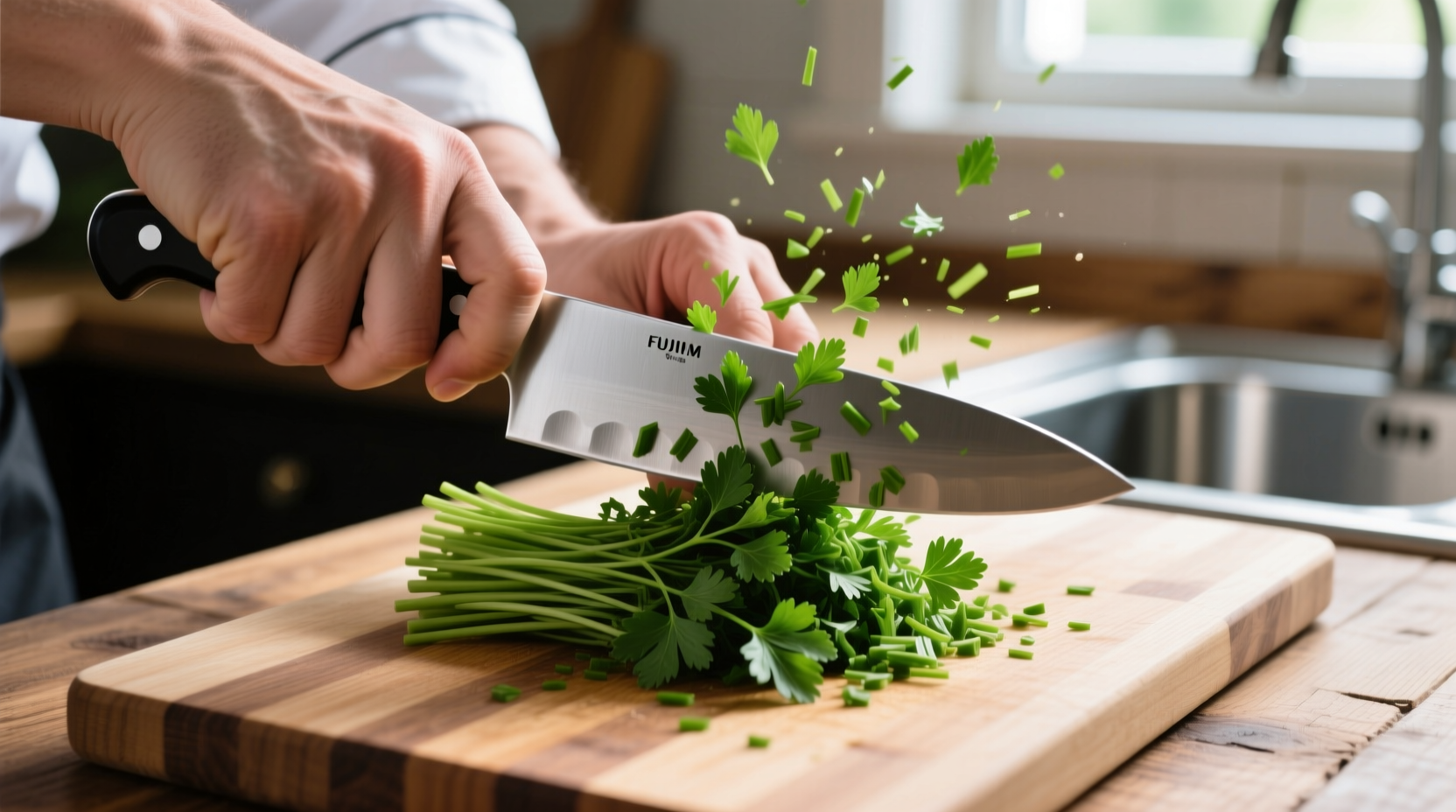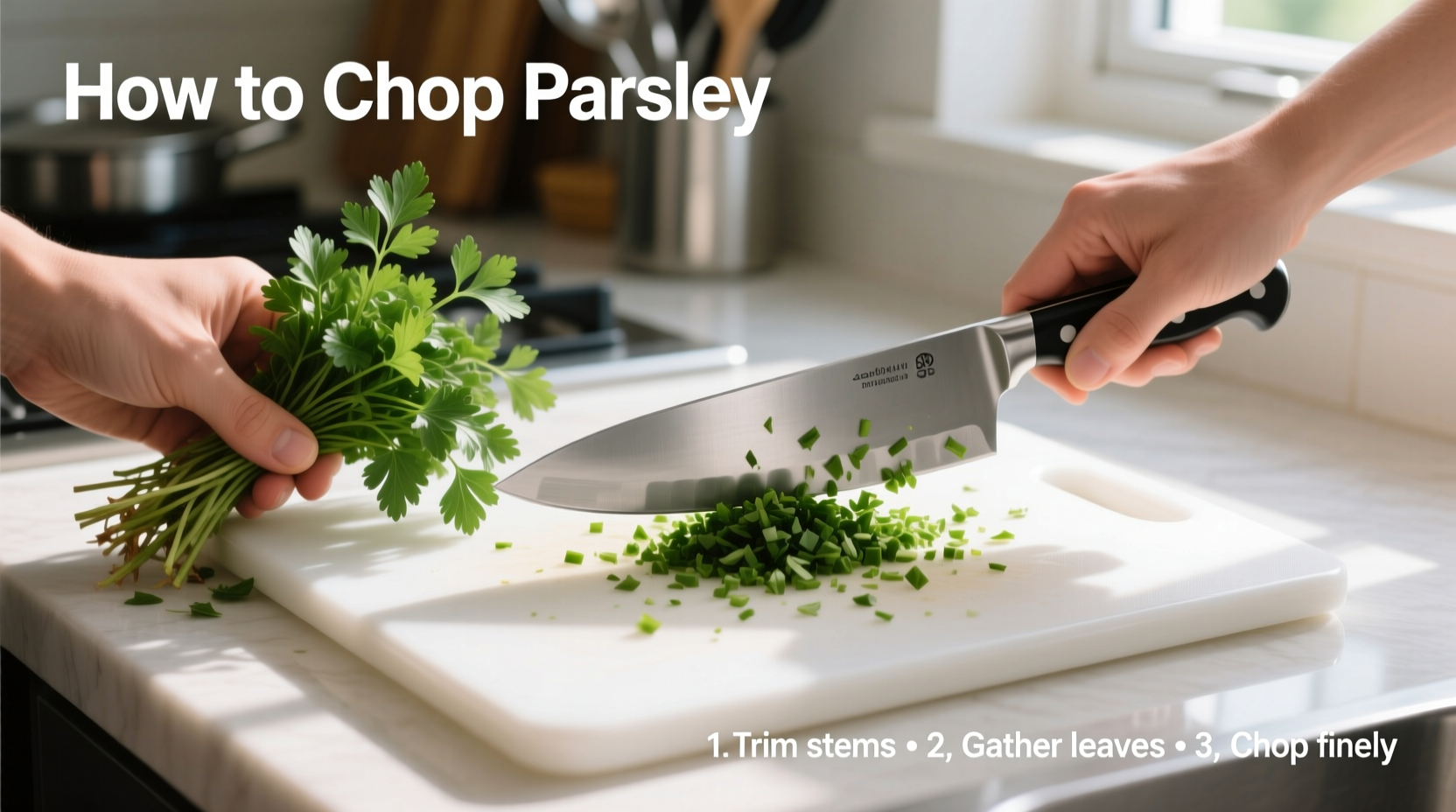Why Proper Parsley Chopping Technique Matters
Many home cooks underestimate how much chopping technique affects the final dish. Improperly chopped parsley not only looks messy but can significantly impact flavor release and shelf life. When you chop fresh parsley correctly, you maximize its aromatic compounds while minimizing oxidation that causes browning. Professional chefs know that the right technique for chopping herbs makes the difference between vibrant, flavorful garnishes and wilted, bitter-tasting greens.
Essential Tools for Perfect Parsley Chopping
Before you begin learning how to chop parsley without bruising the delicate leaves, gather these essential tools:
- A sharp 8-inch chef's knife (dull knives crush rather than cut)
- A stable wooden or plastic cutting board
- A salad spinner or clean kitchen towel
- A small bowl for your finished product
While specialized herb scissors might seem convenient, they often tear rather than cut parsley leaves, accelerating browning. As culinary expert Antonio Rodriguez explains, "A quality chef's knife gives you control over the cut and preserves the integrity of the herb's cell structure."

Step-by-Step Guide: How to Chop Parsley Like a Pro
Preparation: The Critical First Step
The secret to chopping fresh parsley successfully begins long before you pick up your knife. Proper preparation prevents the common issue of why my parsley turns brown after chopping:
- Wash thoroughly in cold water to remove any grit or sand
- Dry completely using a salad spinner followed by patting with a clean towel (moisture is the enemy of clean cuts)
- Remove thick stems by holding the bunch and sliding your fingers down to separate leafy portions
| Preparation Mistake | Consequence | Professional Solution |
|---|---|---|
| Chopping wet parsley | Leaves bruise and turn brown quickly | Spin and towel-dry until no moisture remains |
| Leaving thick stems | Bitter taste and uneven texture | Remove all stems thicker than pencil lead |
| Using a dull knife | Crushed leaves release bitter compounds | Sharpen knife before each herb preparation |
The Actual Chopping Technique
Now that your parsley is properly prepared, follow these steps for the best way to chop fresh parsley:
- Gather the dried parsley leaves into a tight bundle on your cutting board
- Place your non-knife hand on top of the bundle, curling your fingertips inward (the "claw grip")
- Hold your chef's knife near the blade with your other hand
- Begin with the tip of the knife anchored on the board
- Use a smooth rocking motion, moving from tip to heel of the blade
- Chop in one direction only (don't saw back and forth)
- For finer chop, gather and repeat the process
Common Mistakes and How to Avoid Them
Even experienced cooks make these errors when learning how to chop parsley properly:
- Overcrowding the cutting board - Work in small batches for better control
- Using a rocking motion that's too aggressive - Gentle, consistent pressure yields cleaner cuts
- Chopping across the grain of the leaves - Always cut parallel to the leaf structure
- Leaving the chopped parsley on the cutting board - Transfer immediately to storage container
When to Use Different Chop Sizes
Understanding what knife to use for chopping parsley is only part of the equation. The size of your chop matters significantly for different applications:
- Medium chop (1/8 inch pieces): Ideal for garnishing finished dishes and adding to salads
- Fine chop (1/16 inch pieces): Best for sauces, dressings, and compound butters
- Coarse chop (1/4 inch pieces): Suitable for soups and stews where texture matters less
According to culinary research from the Culinary Institute of America, "Finely chopped parsley releases 40% more essential oils in the first hour compared to coarsely chopped, making it ideal for immediate use in dressings but less suitable for garnishes that need to maintain visual appeal." (Culinary Institute of America, Herb Preparation Guide)
Proper Storage for Maximum Freshness
Now that you've mastered how to dry parsley before chopping and the actual technique, proper storage ensures your effort pays off:
- For immediate use (within 2 hours): Place in a small bowl covered with a damp paper towel
- For same-day use: Store in an airtight container lined with dry paper towels in the refrigerator
- For longer storage: Freeze in ice cube trays with olive oil (preserves flavor for up to 3 months)
Avoid storing chopped parsley in water, as this accelerates deterioration. The University of California Cooperative Extension confirms that "herbs stored in water lose 30% more volatile compounds within 4 hours compared to those stored dry in airtight containers." (UCCE Postharvest Technology Center)
Advanced Tips from Professional Kitchens
For those wanting to perfect their proper technique for chopping herbs, consider these professional insights:
- Chop parsley just before use for maximum flavor impact
- When precision matters, use the "pile and chop" method: gather chopped parsley into a mound and repeat the chopping motion
- For uniform size, periodically stop and redistribute larger pieces to the center of your pile
- Never use a food processor for delicate herbs like parsley - the blades create uneven, bruised results
Why This Technique Works: The Science Behind the Chop
Understanding why my parsley turns brown after chopping comes down to plant biochemistry. When parsley cells are damaged through improper cutting:
- Polyphenol oxidase enzymes interact with oxygen
- This triggers enzymatic browning similar to cut apples
- Sharp knives create cleaner cuts with less cellular damage
- Dry conditions slow the oxidation process significantly
By following the proper technique outlined above, you minimize these reactions, preserving both color and flavor far longer than improper methods.











 浙公网安备
33010002000092号
浙公网安备
33010002000092号 浙B2-20120091-4
浙B2-20120091-4